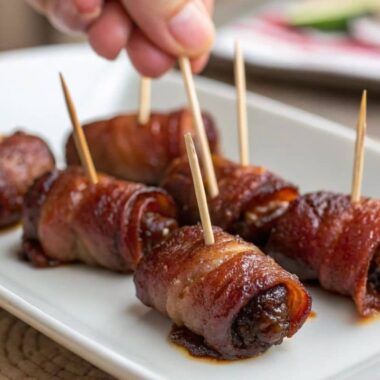If you’re a fan of rich, indulgent flavors, bacon-wrapped beef filet is going to blow your mind. Think about it—tender, juicy beef filet hugged by crispy, smoky bacon. It’s the culinary equivalent of wrapping a gift in silk. This dish is perfect for date nights, family dinners, or when you just want to feel like a gourmet chef in your own kitchen. So, ready to dive in? Let’s break it down step by step.
Table of Contents
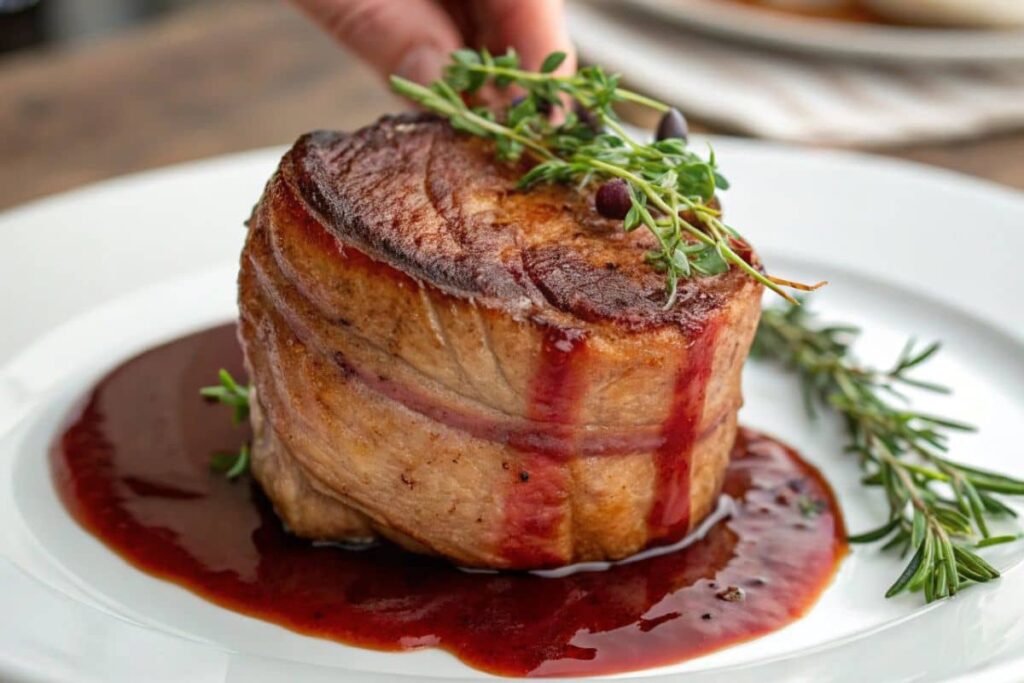
Why Bacon Wrapped Beef Filet is a Culinary Masterpiece
The Allure of Combining Beef and Bacon
Why does bacon wrapped around beef filet work so well? It’s the perfect marriage of flavors. The salty, smoky goodness of the bacon enhances the rich, beefy flavor of the filet. Plus, as the bacon cooks, it bastes the filet, keeping it juicy and adding a touch of crispiness. It’s like a self-saucing dessert but savory!
History and Popularity of Bacon Wrapped Beef Filet
Bacon-wrapped filet isn’t a new invention. It has roots in classic European cooking, where chefs wrapped meats in fat or cured products to enhance moisture and flavor. Over time, this technique evolved, and today it’s a staple in steakhouses around the world. It’s the kind of dish that screams “special occasion” but is simple enough for a weekday dinner.
“Wrapping beef in bacon isn’t just a cooking method—it’s a flavor revolution!”
Selecting the Perfect Beef Filet for Wrapping
Grades of Beef Filet: Prime, Choice, or Select?
Here’s the deal: not all beef is created equal. For bacon-wrapped beef filet, you want to aim for the best quality you can afford. Prime is the gold standard, with perfect marbling and tenderness. Choice is a great middle ground, offering good flavor at a more budget-friendly price. Avoid Select, as it can be too lean and might dry out—even with the bacon.
How to Choose the Right Thickness
Thickness matters—a lot. You’re aiming for filets that are about 1.5 to 2 inches thick. Why? Thicker cuts cook more evenly and retain their juiciness. Anything thinner, and you risk overcooking the meat before the bacon gets crispy.
Fresh vs. Frozen: Does It Make a Difference?
Fresh filets are always the best choice, but if frozen is your only option, no worries! Just make sure to thaw them completely in the fridge before cooking. A partially frozen filet will cook unevenly, leaving you with a raw center and burnt bacon—yikes!
Bacon Choices: Selecting the Best Cut and Flavor
Should You Use Thick or Thin Bacon?
This is a question that divides home cooks everywhere. Thick bacon adds a heartier bite but takes longer to cook, which can leave you with uneven results. Thin bacon crisps up faster and wraps tightly around the filet, making it the better option for this recipe.
Flavored Bacon: Does It Work for Beef Filet?
Flavored bacon, like maple or pepper-crusted, can add an interesting twist. However, keep in mind that the bacon should complement the beef, not overpower it. If you’re a purist, stick with classic smoked or applewood bacon for the best results.
Tips for Preparing Bacon for Wrapping
Before wrapping your filets, partially cook the bacon. Why? Because beef filet cooks much faster than bacon. Giving the bacon a head start ensures it’ll be crispy by the time the beef is done. Lay the bacon strips on a sheet pan and bake them at 375°F (190°C) for about 5 minutes—just until they start to render fat but are still pliable.
Preparing Your Bacon Wrapped Beef Filet: Step-by-Step
Essential Tools and Ingredients You’ll Need
Let’s get organized. Here’s what you’ll need:
| Ingredient/Tool | Quantity |
|---|---|
| Beef filets | 4 (1.5-2 inches thick) |
| Bacon strips | 8 (thin-cut) |
| Olive oil | 1 tablespoon |
| Salt and pepper | To taste |
| Toothpicks | 4 (optional) |
Wrapping Techniques for a Secure and Even Cook
Here’s where the magic happens:
- Season your filets generously with salt and pepper on all sides.
- Wrap each filet with 2 strips of bacon, slightly overlapping them to cover the sides completely.
- Secure the bacon with a toothpick or tie it with kitchen twine. (Pro tip: If you use toothpicks, remember to remove them before serving!)
Should You Use Toothpicks or Kitchen Twine?
Both work, but it’s a personal preference. Toothpicks are quicker and easier to use, while kitchen twine gives a cleaner, more professional look. Either way, they’ll keep your bacon snugly in place.
Cooking Techniques for Perfect Results
Pan-Seared and Oven-Finished Method
This is the go-to method for restaurant-quality results. Start by searing the filets in a hot skillet with olive oil for about 2 minutes per side, until the bacon is crispy. Then transfer the skillet to a preheated oven at 400°F (200°C) and roast for 8-12 minutes, depending on your preferred doneness.
Grilling Bacon Wrapped Beef Filet
Love that smoky flavor? Grilling is an excellent option. Preheat your grill to medium-high heat, then cook the filets for 6-8 minutes per side, turning frequently to prevent flare-ups. Keep the lid closed for even cooking.
Sous Vide: The Foolproof Technique for Perfection
If you’re a perfectionist, sous vide is your best friend. Vacuum-seal the bacon-wrapped filets and cook them in a water bath at 129°F (54°C) for 1.5 hours. Finish with a quick sear in a hot skillet for crispy bacon.
Common Mistakes and How to Avoid Them
Mistakes happen, but they don’t have to ruin dinner! Here’s how to avoid the most common pitfalls:
- Bacon Burns: Partially cook it beforehand to even out cooking times.
- Uneven Cooking: Use filets of uniform thickness and a reliable meat thermometer.
- Bacon Falls Off: Secure it tightly with toothpicks or twine.
Perfect Pairings: Side Dishes and Sauces to Complement Your Dish
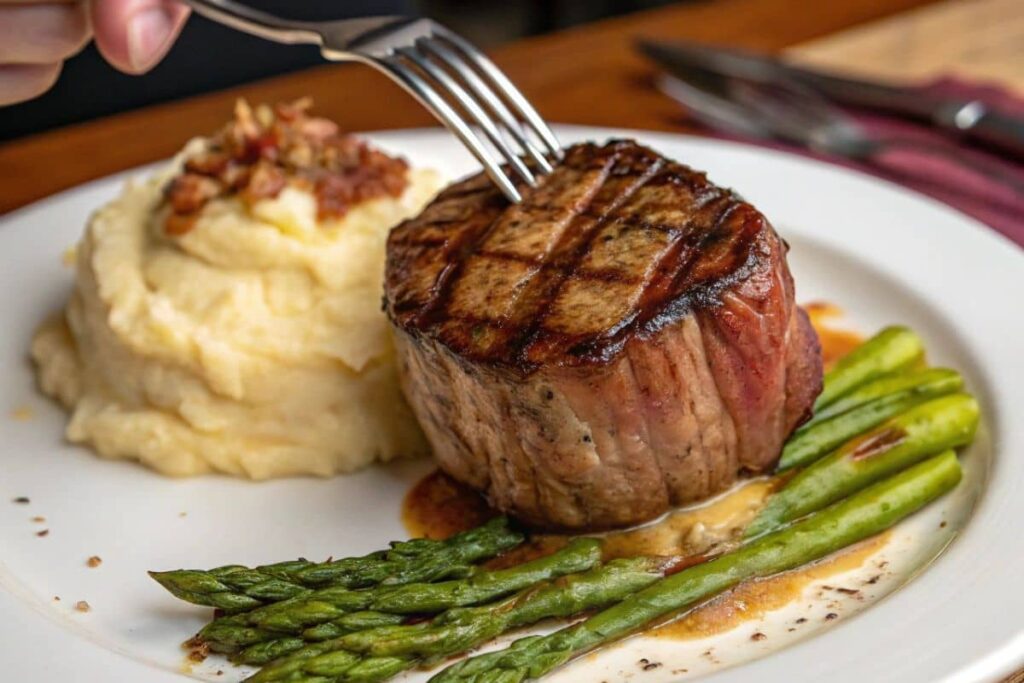
Classic Potato-Based Sides
What pairs better with a rich, savory dish like bacon-wrapped beef filet than a comforting potato side? Mashed potatoes are the ultimate classic—creamy, buttery, and just indulgent enough to complement the star of the plate. Want something fancier? Try roasted garlic herb potatoes or even a decadent potato gratin. The crispy edges of roasted potatoes or the velvety texture of gratin create a mouthwatering contrast to the juicy beef filet.
Vegetable Pairings for a Balanced Plate
If you’re looking to add a splash of color and freshness, roasted vegetables are a fantastic choice. Think asparagus spears lightly drizzled with olive oil and sprinkled with sea salt. Or maybe sautéed green beans with a touch of garlic and lemon zest. The vegetables’ lightness and slight crunch balance the richness of the bacon and beef beautifully.
Best Sauces to Enhance the Flavor
No dish is complete without a sauce to tie it all together. A classic red wine reduction or peppercorn sauce is a match made in heaven. If you’re feeling adventurous, a blue cheese butter or a balsamic glaze adds an unexpected pop of flavor that will have everyone at the table talking.
“The right side dish or sauce doesn’t just complement your bacon-wrapped beef filet—it elevates it to culinary greatness.”
Troubleshooting Common Problems
Bacon Burns Before Beef is Cooked: Solutions
This is a common problem, but it’s super easy to fix. The trick? Partially cook the bacon beforehand and keep the heat moderate during cooking. If you’re grilling, avoid direct flames. A quick wrap in aluminum foil can also help protect the bacon while the beef cooks through.
Uneven Cooking: What Went Wrong and Fixes
If your beef filet is raw in the center and overdone on the outside, the issue is likely uneven heat or a cut that’s too thick. Always preheat your oven, skillet, or grill for consistent heat distribution. Use a meat thermometer to ensure your filet reaches your desired doneness—around 130°F (54°C) for medium rare.
Bacon Falls Off During Cooking: Tips to Prevent This
Nothing ruins the presentation like bacon that won’t stay put. Make sure to wrap the bacon tightly and secure it with toothpicks or kitchen twine. Cooking the filets seam-side down first also helps hold everything together as it cooks.
Serving and Presentation Tips
Plating Ideas for a Gourmet Look
Presentation matters, especially for a dish as elegant as this one. Place your filet in the center of a clean, white plate (it really makes the colors pop). Arrange your sides around it, like roasted asparagus on one side and a dollop of mashed potatoes on the other. For an added touch, drizzle your sauce in a decorative pattern around the plate.
Garnishes to Elevate the Aesthetic
Sometimes, it’s the little things that make a dish stand out. Fresh herbs like thyme or rosemary not only add a pop of green but also enhance the aroma. A sprinkle of flaky sea salt or a crack of fresh black pepper just before serving adds the final flourish.
How to Store and Reheat Leftovers Without Losing Quality
Best Practices for Refrigeration and Freezing
If you have leftovers (lucky you!), store them properly to keep them delicious. Wrap the filets tightly in aluminum foil or place them in an airtight container. Refrigerate for up to three days or freeze for up to two months.
Reheating Without Drying Out the Beef or Bacon
Reheating steak can be tricky, but there’s a way to do it right. For refrigerated leftovers, warm them in the oven at 250°F (120°C) until heated through. For frozen filets, let them thaw in the fridge overnight before reheating. Avoid the microwave—it’ll zap all the juiciness out!
Health Considerations and Nutritional Facts
Wondering if bacon-wrapped beef filet fits into your diet? Here’s a quick look at its nutritional profile:
| Nutrient | Per Serving |
|---|---|
| Calories | 350 |
| Protein | 30g |
| Fat | 25g |
| Carbohydrates | 0g |
| Sodium | 700mg |
Healthier Alternatives Without Sacrificing Flavor
If you’re watching your intake, there are ways to lighten up this dish. Opt for turkey bacon instead of traditional pork bacon, or use a leaner cut of beef like sirloin. You can also pair it with lighter sides, like a fresh salad, to balance out the meal.
Frequently Asked Questions About Bacon Wrapped Beef Filet
Can I Cook This Dish Ahead of Time?
Yes, but it’s best enjoyed fresh. You can partially cook the bacon-wrapped filets ahead of time and finish them in the oven just before serving. This trick is especially handy if you’re hosting guests!
What’s the Best Bacon to Use for a Smoky Flavor?
Applewood-smoked bacon is a crowd favorite. Its subtle sweetness and smoky aroma pair perfectly with the richness of the beef filet. Hickory-smoked bacon is another excellent choice for a bolder flavor.
How Long Should I Cook the Filet for Medium Rare?
Aim for an internal temperature of 130°F (54°C). Depending on the cooking method, this usually takes about 8-12 minutes in the oven after searing, or around 6-8 minutes per side on the grill.
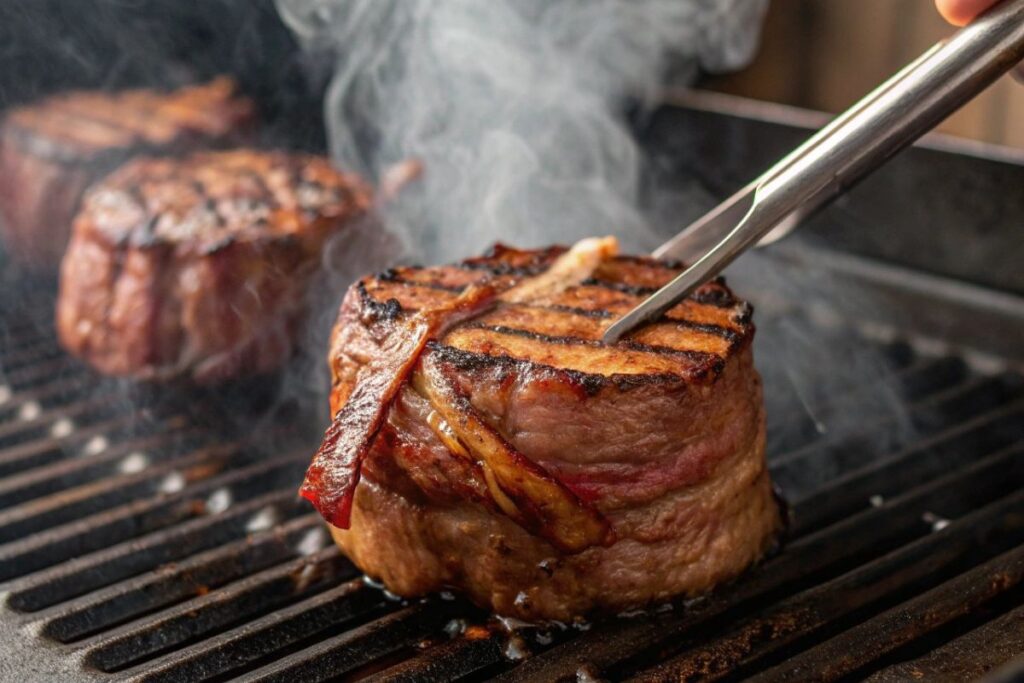
Conclusion: Mastering the Art of Bacon Wrapped Beef Filet
Recap of Key Tips for Success
From choosing the right beef and bacon to nailing the cooking technique, bacon-wrapped beef filet is easier than it looks. The key is attention to detail—thickness, temperature, and timing all matter.
Encouragement to Experiment with Pairings and Techniques
Don’t be afraid to get creative! Try different bacon flavors, experiment with sauces, or even explore new cooking methods.
“Cooking is an art, and bacon-wrapped beef filet is your masterpiece. So go ahead, create something unforgettable!”
Explore more related articles to expand your culinary knowledge! Learn all about beef bacon, master it with our detailed guide “How to Cook Beef Bacon“, and discover whether it’s a healthy choice in “Is Beef Bacon Unhealthy?“. Curious about other delicacies? Dive into the world of salmon roe and its versatile gourmet uses.
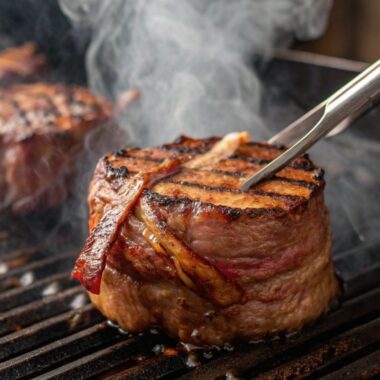
Bacon-Wrapped Beef Filet
Ingredients
Main Ingredients
- 4 pieces Beef filets (1.5-2 inches thick) Choose prime or choice grade for best results.
- 8 strips Thin-cut bacon Partially cooked before wrapping.
- 1 tablespoon Olive oil For searing the filets.
- to taste Salt and pepper Season generously before wrapping.
- 4 pieces Toothpicks (optional) For securing the bacon.
Instructions
Preparation
- Preheat your oven to 400°F (200°C).
- Partially cook the bacon by laying it on a sheet pan and baking at 375°F (190°C) for 5 minutes until it starts to render fat but is still pliable.
- Season the filets generously with salt and pepper on all sides.
- Wrap each filet with 2 strips of bacon, slightly overlapping them to cover the sides completely.
- Secure the bacon with a toothpick or kitchen twine.
Cooking
- Heat olive oil in a hot skillet and sear the filets for about 2 minutes on each side, until the bacon is crispy.
- Transfer the skillet to the preheated oven and roast for 8-12 minutes, depending on your preferred doneness.

